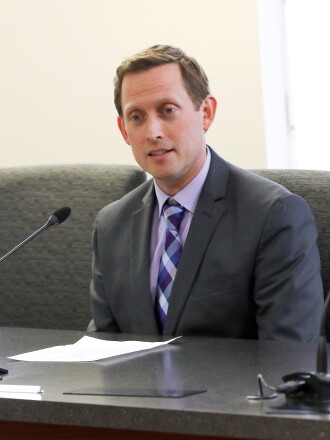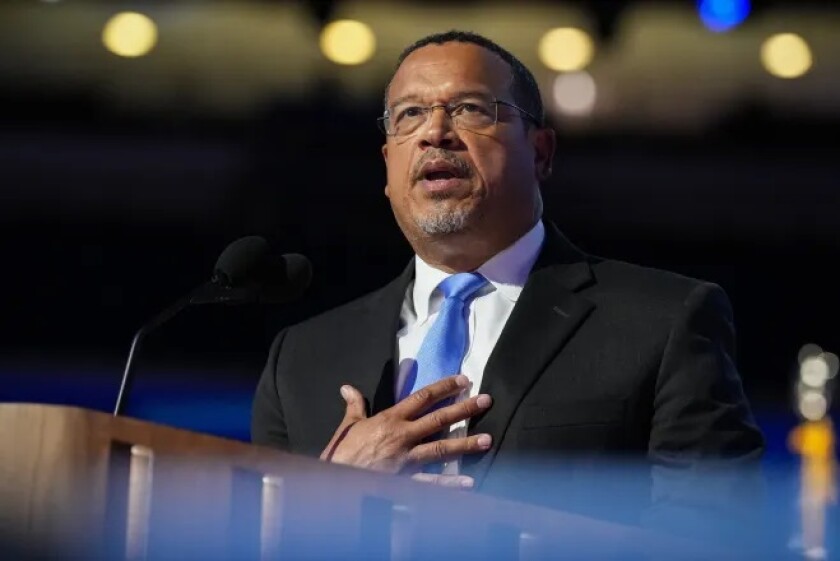ST. PAUL — Northland school superintendents pleaded with lawmakers at the Minnesota Capitol this week to cut them a break as they begin another year of deep budget cuts.
Officials representing several districts, mostly from the Twin Cities metro and Northeastern Minnesota, testified Wednesday at an Education Finance Committee hearing led by Co-Chair Sen. Jason Rarick, R-Pine City.
ADVERTISEMENT
‘We need some help up here in northern Minnesota’
St. Louis County Schools
- Largest district geographically in state at over 4,000 square miles
- Schools in Babbitt, Cherry, Culver, Orr, Tower
- 1,825 students in pre-K-12
“We are bordered by 18 public school districts, one charter school, one foreign country and two sovereign nations,” Superintendent Kim Johnson, who testified remotely, said Wednesday. “We transport students and staff 1.5 million miles per year. We kind of live in a community day care desert."

Since fiscal year 2020, St. Louis County Schools has lost 193 students, which has resulted in a loss of nearly $5.1 million, Johnson said.
Her district, she said, is “getting very, very close” to statutory operating debt. It’s planning budget cuts totaling around $1.5 million.
“We’ve already cut 10 teachers in the current fiscal year,” Johnson said. “We have another 12 teachers that will be cut in fiscal year 2025-26. ... We’re looking at another $700,000 the district is going to have to cut because of some of the proposals Gov. Walz is putting on the table."
In May 2023, Minnesota became the first state to pass a law making hourly wage workers like paraprofessionals, bus drivers and kitchen workers eligible for unemployment benefits during the summer. About $135 million was set aside to fund the unemployment insurance mandate for the following two years, and now that money is running out.
In Gov. Tim Walz's proposed 2026-27 budget, he recommends $30 million in fiscal year 2026 for a one-time extension of the unemployment aid.
ADVERTISEMENT
St. Louis County Schools had to hire an employee to manage record-keeping for the earned sick and safe time and the summer unemployment benefits.
“When we are in financial difficulties and the district administrative office has to hire staff, it looks absolutely terrible,” Johnson said. “We want to keep that funding in the classrooms.”
However, the summer unemployment benefits have helped the district keep employees, she noted.
Like many districts in greater Minnesota, St. Louis County Schools doesn’t have an operating referendum. Johnson asked lawmakers to consider seasonal recreation tax replacement aid legislation.
To reduce school referendum levies, Sen. Grant Hauschild, DFL-Hermantown, and Rep. Dave Lislegard, DFL-Aurora, introduced companion bills last year to create seasonal tax base replacement aid for school districts. The legislation wouldn’t change how seasonal property is taxed and would still require voters to approve operating levies.
About 40% of the property in the St. Louis County Schools district is seasonal and recreational, Johnson said, so it currently won’t contribute to an operating levy.
'Pretty significant cuts’ are likely
Cloquet Public Schools
ADVERTISEMENT
- About 2,724 students in pre-K-12
- Largest district enrollment in Carlton County
If summer unemployment benefits are not fully funded this year, Cloquet Public Schools will need to cut about $200,000, said Superintendent Michael Cary, who testified remotely.
If compensatory revenue is lost, the district will need to cut another $200,000, he said.

All Minnesota students receive free breakfast and lunch through the state's Free School Meals for Kids Program signed into law in 2023. However, eligibility for the federal free and reduced-price meals program is still used to determine state and federal aid for other programs. The state uses free and reduced-price meals enrollment of students in early childhood through 12 grade to determine what a district receives in compensatory revenue — funding used to serve students under-prepared to learn or below the appropriate level for learners their age.
When Free School Meals for Kids was implemented, there was no longer an incentive for families to submit the forms tied to free and reduced-price meals, so the revenue formula was changed so schools wouldn’t see less money if they couldn't collect forms.

In his proposed budget, Walz recommends $39.78 million in fiscal year 2026 and $4.42 million in fiscal year 2027 to keep the compensatory revenue consistent.
Cary said the number of state mandates has taken a toll on morale.
“What I worry about,” he said, “is if we’re not really conscientious about the pace of that change that we’re demanding, it leads to apathy. It leads to people becoming, I’ll say, demoralized with their work.
ADVERTISEMENT
“We all understand the positive intentions of these things that are occurring,” he said of the mandates.
Rather than mandating change, he suggested “supporting financially and through providing additional time to our staff.”
Cary said when he started working as a school administrator 20 years ago, staff “spent a lot of time talking about innovation. ... And we were to make that change at a pace that worked for our people and worked for our leadership team. Right now, that demeanor has very, very much changed.”
The deflating morale is a statewide problem, he said, which has led to more difficulty recruiting teachers.
“I think it’s a lurking thing that’s quietly building. … We’re seeing fewer and fewer people apply for education jobs,” he said. “We’re seeing fewer and fewer people enter into education fields at universities.”
‘I have people worried about their jobs’
Grand Rapids Area Schools
- Approx. 4,000 students
- “About the size of Delaware” at over 2,200 square miles
Superintendent Matt Grose is in his fifth year at Grand Rapids Area Schools, which is in its sixth consecutive year of budget reductions. The district spends $1,300 less per student than the state average, “and we receive $1,300 less than the state average,” he said.
ADVERTISEMENT
“I have teachers coming to work doing one and a half people’s jobs,” he said. “I have principals lying awake at night wondering how they’re going to run their schools next fall with less people.”
Grose said his district could see a $600,000 reduction in compensatory revenue heading into next year. Summer unemployment aid ending could mean a loss of $225,000.

Grand Rapids Area Schools was looking forward to its first year in six years without budget cuts.
“With these aids leaving, that scenario is off the table,” Grose said.
Like St. Louis County Schools, the Grand Rapids district doesn’t have an operating referendum. Its last operating referendum was defeated by a margin of 3-to-1.
“We had the same exact dollar-amount-per-pupil ask as Richfield,” Grose said, “but our taxpayers in Grand Rapids — (the) impact was 2 1/2 times the taxpayers in Richfield.”
He also advocated for seasonal recreation tax replacement aid. If seasonal and recreational property owners contributed to operating referendums, it would boost his district’s revenue by 20%.
ADVERTISEMENT
“It would help districts like mine,” Grose said. “It would help districts like St. Louis County and many of the others in Northeastern Minnesota.”
‘We’re at a precipice’
Hibbing Public Schools
- Over 2,100 students
- Class of 2024 – 175 students; biggest class ever, 1971 – 463 students
Kim McLaughlin, chair pro-tem and treasurer of the Hibbing School Board, testified remotely alongside Superintendent Rick Aldrich. She told legislators the Postsecondary Enrollment Options program has benefited her district in some ways.
“PSEO is a wonderful educational opportunity for students and their families,” she said. “Especially where families and students face significant socioeconomic barriers.”

Minnesota’s Postsecondary Enrollment Options Act allows students in grades 10-12 to earn college credits while still in high school. Tuition is free. The Minnesota Department of Education usually pays the tuition, fees and supplies directly to the enrolled student’s postsecondary school, not their high school.
However, of the approximately 340 students in 11th and 12th grades at Hibbing High School, about one-quarter are choosing PSEO. There’s even a campus four blocks from the high school: Minnesota North College.
The number of students enrolled in PSEO means the district loses more than $500,000 in state aid.
McLaughlin said that loss of state aid affects her district’s curriculum, support services, activities and facilities. She asked lawmakers to review the PSEO funding formula, noting that it’s creating competition between K-12 schools and colleges.
In fiscal year 2020, the Hibbing district’s unassigned fund balance was $8.1 million. It ended 2024 with just $1.3 million, even after reductions were made during the COVID-19 pandemic to “not fall off the cliff,” Aldrich said.
A Hibbing High School graduate, Aldrich took the reins as superintendent in 2019. The pandemic hit six months later. Since then, he said, “Our district has been in a state of decline. Serious decline.
"We’ve lost nearly 300 students in that time," he said. "Our homeschool numbers have gone from about 15 to I think right around 90 today. We are a loser in open enrollment.”
About 430 students leave the district each year and only about 220 come in.
“We need your help,” Aldrich told legislators. “We’re at a cliff. We’ve been diligent with our finances.”
Hibbing Public Schools is considering nearly $2.5 million in cuts this spring.
“That’s going to be devastating for our staff,” Aldrich said. “And that comes at a time when all of my buildings have concerns about safety.
“We need your help,” he said. “I don’t know what else to say.”
Stop ‘one-size-fits-all mandates’
Cromwell-Wright Public Schools
- 296 students
- Smallest district in Carlton County
Cromwell-Wright Public Schools was likely the smallest district represented during the Education Finance Committee hearing Wednesday. Superintendent Nathan Libbon said it’s “the flagship of our community.”
The tiny size of the district means losing any revenue makes a big impact.

In 2024, summer unemployment aid equaled just under $54,000 for about 10 paraprofessionals, three kitchen workers and some other support services staff, Libbon said.
If compensatory aid is cut by about $40,000, as expected, the district would have to reduce one teacher position out of only about 20.
Libbon urged legislators to make decisions quickly, as his district is considering budget cuts this month. He emphasized the need for local control.
“Please empower us to do the job that our local community has charged us with,” he said.
What’s next
“We hear loud and clear your nervousness around unemployment insurance dollars going away,” the other Education Finance Committee co-chair, Sen. Mary Kunesh, DFL-New Brighton, said after the testimony Wednesday, “so we still have a pretty good balance in that account, so you shouldn’t have to take that out of your general (fund).”
Kunesh told the school officials: “If you’re looking at what’s happening at the national level, and have any insight or concerns about any of the funding that has been threatened or might be threatened, we’d love to hear your perspective on that and how that will affect your school districts in the future.”
On Thursday, Senate Republicans announced their five-part “Minnesota First” agenda for the 2025 session. Regarding education, it pledges to “authorize local school boards to waive state mandates enacted after January 1, 2023” and “address funding disparities by allocating all dollars on a per pupil basis.”
House Democrats have boycotted the legislative session for the past two weeks to prevent Republicans from taking control of the chamber.
House Republicans announced Thursday they are suing Minnesota Secretary of State Steve Simon
to force DFL members back to work.
























